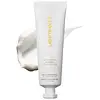What's inside
What's inside
 Key Ingredients
Key Ingredients

 Benefits
Benefits

 Concerns
Concerns

 Ingredients Side-by-side
Ingredients Side-by-side

Zinc Oxide 14.28%
Cosmetic ColorantWater
Skin ConditioningCaprylic/Capric Triglyceride
MaskingNiacinamide
SmoothingButyloctyl Salicylate
Skin ConditioningPropanediol
SolventSqualane
EmollientAloe Barbadensis Leaf Juice
Skin ConditioningSodium Acrylate/Sodium Acryloyldimethyl Taurate Copolymer
Emulsion StabilisingCetyl Alcohol
EmollientGlycol Stearate
EmollientHelianthus Annuus Seed Oil
EmollientHydroxyacetophenone
AntioxidantPolyisobutene
Glycerin
HumectantGlyceryl Stearate
EmollientLecithin
EmollientIsostearic Acid
CleansingPolyglyceryl-3 Polyricinoleate
EmulsifyingPolyhydroxystearic Acid
EmulsifyingVaccinium Vitis-Idaea Fruit Extract
AntioxidantXanthan Gum
EmulsifyingCaprylyl/Capryl Glucoside
CleansingSorbitan Oleate
EmulsifyingPhenoxyethanol
PreservativeCitric Acid
BufferingGluconolactone
Skin ConditioningPlankton Extract
Skin ConditioningSodium Benzoate
MaskingPotassium Sorbate
PreservativeCalcium Gluconate
HumectantJojoba Esters
EmollientAlumina
AbrasiveSilica
AbrasiveCI 77891
Cosmetic ColorantIron Oxides
Zinc Oxide 14.28%, Water, Caprylic/Capric Triglyceride, Niacinamide, Butyloctyl Salicylate, Propanediol, Squalane, Aloe Barbadensis Leaf Juice, Sodium Acrylate/Sodium Acryloyldimethyl Taurate Copolymer, Cetyl Alcohol, Glycol Stearate, Helianthus Annuus Seed Oil, Hydroxyacetophenone, Polyisobutene, Glycerin, Glyceryl Stearate, Lecithin, Isostearic Acid, Polyglyceryl-3 Polyricinoleate, Polyhydroxystearic Acid, Vaccinium Vitis-Idaea Fruit Extract, Xanthan Gum, Caprylyl/Capryl Glucoside, Sorbitan Oleate, Phenoxyethanol, Citric Acid, Gluconolactone, Plankton Extract, Sodium Benzoate, Potassium Sorbate, Calcium Gluconate, Jojoba Esters, Alumina, Silica, CI 77891, Iron Oxides
Water
Skin ConditioningDibutyl Adipate
EmollientOctocrylene
UV AbsorberCyclopentasiloxane
EmollientDicaprylyl Carbonate
EmollientAlcohol Denat.
AntimicrobialTitanium Dioxide
Cosmetic ColorantButyl Methoxydibenzoylmethane
UV AbsorberCyclohexasiloxane
EmollientBis-Ethylhexyloxyphenol Methoxyphenyl Triazine
Skin ConditioningButylene Glycol
HumectantPEG-30 Dipolyhydroxystearate
EmulsifyingNylon-12
Dimethicone
EmollientPEG-10 Dimethicone
Skin ConditioningSodium Chloride
MaskingPhenoxyethanol
PreservativeSilica
AbrasiveDisteardimonium Hectorite
StabilisingTocopheryl Acetate
AntioxidantGlyceryl Stearate
EmollientParfum
MaskingBisabolol
MaskingDisodium EDTA
Ethylhexylglycerin
Skin ConditioningPanthenol
Skin ConditioningPEG-8
HumectantTocopherol
AntioxidantLecithin
EmollientPlankton Extract
Skin ConditioningAscorbyl Palmitate
AntioxidantAscorbic Acid
AntioxidantCitric Acid
BufferingWater, Dibutyl Adipate, Octocrylene, Cyclopentasiloxane, Dicaprylyl Carbonate, Alcohol Denat., Titanium Dioxide, Butyl Methoxydibenzoylmethane, Cyclohexasiloxane, Bis-Ethylhexyloxyphenol Methoxyphenyl Triazine, Butylene Glycol, PEG-30 Dipolyhydroxystearate, Nylon-12, Dimethicone, PEG-10 Dimethicone, Sodium Chloride, Phenoxyethanol, Silica, Disteardimonium Hectorite, Tocopheryl Acetate, Glyceryl Stearate, Parfum, Bisabolol, Disodium EDTA, Ethylhexylglycerin, Panthenol, PEG-8, Tocopherol, Lecithin, Plankton Extract, Ascorbyl Palmitate, Ascorbic Acid, Citric Acid
Ingredients Explained
These ingredients are found in both products.
Ingredients higher up in an ingredient list are typically present in a larger amount.
Citric Acid is an alpha hydroxy acid (AHA) naturally found in citrus fruits like oranges, lemons, and limes.
Like other AHAs, citric acid can exfoliate skin by breaking down the bonds that hold dead skin cells together. This helps reveal smoother and brighter skin underneath.
However, this exfoliating effect only happens at high concentrations (20%) which can be hard to find in cosmetic products.
Due to this, citric acid is usually included in small amounts as a pH adjuster. This helps keep products slightly more acidic and compatible with skin's natural pH.
In skincare formulas, citric acid can:
While it can provide some skin benefits, research shows lactic acid and glycolic acid are generally more effective and less irritating exfoliants.
Most citric acid used in skincare today is made by fermenting sugars (usually from molasses). This synthetic version is identical to the natural citrus form but easier to stabilize and use in formulations.
Read more about some other popular AHA's here:
Learn more about Citric AcidGlyceryl Stearate is a mix of glycerin and stearic acid.
It is used to stabilize the mixing of water and oil ingredients. By preventing these ingredients from separating, it can help elongate shelf life. It can also help thicken the product's texture.
As an emollient, it helps soften skin and supports barrier-replenishing ingredients.
In cosmetics, Glyceryl Stearate is often made from vegetable oils or synthetically produced.
This ingredient may not be fungal-acne safe
Fun fact: The human body also creates Glyceryl Stearate naturally.
Learn more about Glyceryl StearateLecithin is a term for a group of substances found in the cell membranes of plants, animals, and humans. They are made up of mixture of phospholipids.
This ingredient has emollient and emulsifying properties.
As an emollient, lecithen helps soften the skin and creates a barrier to keep moisture in.
As an emulsifier, it also helps prevent water and oil ingredients from separating. Lecithin can also help ingredients be better absorbed by the skin.
This is because the phospholipids in lecithin produce liposomes. Liposomes help other ingredients get through the skin barrier.
Depending on the source of this ingredient, lecithin may not be fungal acne safe. This is because some sources of lecithin come from soybean oil, which may feed the malassezia yeast that feeds fungal acne.
We recommend reaching out to the brand you are purchasing from to inquire about the source of their lecithin.
Some other names for this ingredient include soy lecithin and deoiled soy lecithin.
Learn more about LecithinPhenoxyethanol is a preservative that has germicide, antimicrobial, and aromatic properties. Studies show that phenoxyethanol can prevent microbial growth. By itself, it has a scent that is similar to that of a rose.
It's often used in formulations along with Caprylyl Glycol to preserve the shelf life of products.
We don't have a description for Plankton Extract yet.
Silica, also known as silicon dioxide, is a naturally occurring mineral. It is used as a fine, spherical, and porous powder in cosmetics.
Though it has exfoliant properties, the function of silica varies depending on the product.
The unique structure of silica enhances the spreadability and adds smoothness, making it a great texture enhancer.
It is also used as an active carrier, emulsifier, and mattifier due to its ability to absorb excess oil.
In some products, tiny microneedles called spicules are made from silica or hydrolyzed sponge. When you rub them in, they lightly polish away dead skin layers and enhance the penetration of active ingredients.
Learn more about SilicaWater. It's the most common cosmetic ingredient of all. You'll usually see it at the top of ingredient lists, meaning that it makes up the largest part of the product.
So why is it so popular? Water most often acts as a solvent - this means that it helps dissolve other ingredients into the formulation.
You'll also recognize water as that liquid we all need to stay alive. If you see this, drink a glass of water. Stay hydrated!
Learn more about Water